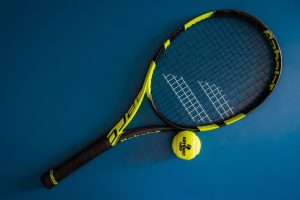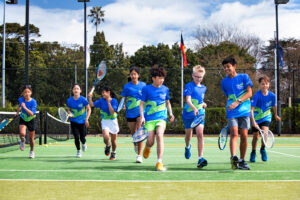Beginner Mistakes Made in Tennis
Starting your tennis journey is an exciting venture filled with potential for growth and enjoyment. Beginners often encounter challenges as they learn the game’s complexities, from mastering techniques to understanding the tactical aspects. It’s natural to make mistakes during this early stage, but identifying and correcting these errors early on is crucial for development.
This article outlines some of the most common mistakes made by beginners and provides guidance on how to steer clear of them. We aim to equip new players with the knowledge to refine their skills, enhance their understanding of the game, and set a strong foundation for their tennis journey. Recognising and addressing these initial hurdles will pave the way for improved play and a more rewarding tennis experience.
Overlooking the Basics of Grip and Stance
Incorrect Grip Techniques
One of the first hurdles beginners face is mastering the correct grip, a fundamental aspect that significantly impacts the effectiveness of different shots. An incorrect grip can limit the power and accuracy of strokes, making it harder to execute a wide range of shots effectively.
- A common mistake is using the same grip for all types of shots, which can restrict versatility and adaptability on the court.
- Another issue is gripping the racket too tightly or loosely, leading to a lack of control over the ball and reducing the ability to impart spin.
- The correct grip varies depending on the shot being played. For example, a continental grip is versatile and used for serves, volleys, and slices, while a semi-western grip is preferred for powerful baseline shots.
Understanding and practising the correct grip for various shots is essential for developing a well-rounded tennis game.
Stance Misunderstandings
Stance plays a critical role in tennis, impacting balance, mobility, and the ability to respond quickly to an opponent’s shots. Misunderstandings about proper stance can lead to ineffective play and increased risk of injury.
- A frequent misunderstanding is the failure to adjust the stance based on the shot. For instance, a wide stance is crucial for groundstrokes to ensure stability and force, whereas a more dynamic stance is needed for volleys to allow quick movements.
- Neglecting to position the feet properly can lead to poor balance and reduced power in shots. The front foot should generally point towards the target for direct shots, while the back foot should anchor and provide the necessary push-off for power.
- Overlooking the importance of bending the knees is another common error. A lower centre of gravity improves balance and enables players to move more swiftly and efficiently across the court.
Recognising and correcting stance misunderstandings is essential for achieving better balance and mobility on the court, enhancing overall performance.
Errors in Serve and Return
Common Serve Mistakes
The serve is a vital aspect of tennis, acting as the game’s opening stroke. However, beginners often encounter several errors that can diminish the effectiveness of their serves.
- An incorrect ball toss is one of the most prevalent mistakes, leading to inconsistent serves. The toss should be neither too high nor too low and should place the ball in a position where the player can hit it at the peak of its arc.
- Failing to use the whole body during the serve can also reduce power and accuracy. The serve should involve a fluid motion incorporating leg drive, hip rotation, and arm extension.
- Neglecting the follow-through is another common error. A complete follow-through is essential for directing the ball accurately and adding spin.
Addressing these common serve mistakes can significantly improve a player’s serve, making it a more powerful and reliable part of their game.
Return Errors Beginners Make
Returning serve effectively is crucial in tennis, yet beginners often struggle with this aspect due to several common mistakes.
- A primary error is poor positioning. Players frequently either stand too close or too far back, making it difficult to respond to different types of serves. Adjusting position based on the server’s style and the kind of serve can improve return effectiveness.
- Another mistake is preparing too late. A quick and early racket preparation allows for better timing and more controlled returns. Watching the server’s motion closely can help anticipate the serve type and speed.
- Misjudging the ball’s trajectory leads to missed or weak returns. Practising reading serves and anticipating where the ball will land can enhance return accuracy.
Correcting these return errors involves mindful practice and understanding serve-return dynamics. By focusing on positioning, preparation, and ball trajectory, beginners can significantly improve their ability to return serves effectively.
Misjudging the Court and Ball
Poor Court Positioning
Incorrect court positioning significantly affects a player’s ability to effectively respond to an opponent’s shots. Being in the wrong place at the wrong time limits reach, reduces the chance of hitting powerful returns and can leave vast areas of the court exposed.
- Staying too far behind the baseline makes attacking or responding quickly to short balls difficult. Conversely, playing too close to the net opens up the back of the court.
- Failing to adjust position based on the opponent’s position and potential shot choices leads to missed opportunities for offensive play or effective defence.
- Not moving to the centre of the baseline after each shot can result in a lack of coverage across the court, making it easier for opponents to find gaps.
Understanding and improving court positioning is essential for enhancing gameplay, allowing players to cover the court more efficiently and anticipate opponents’ shots more effectively.
Underestimating Ball Trajectory
Anticipating the ball’s trajectory is crucial for effective play, yet beginners often struggle to accurately judge the speed and direction, leading to missed or poorly executed shots.
- Observing the opponent’s body language and racket angle at the point of contact can provide clues about the ball’s likely trajectory, helping to anticipate and position oneself more effectively.
- Practising with a variety of players exposes one to different serving styles and shots, improving the ability to predict ball movement.
- Focusing on the ball from the moment it leaves the opponent’s racket allows for quicker reactions and better decision-making.
Improving the anticipation of ball trajectory requires patience and practice but is essential for advancing tennis skills and making more strategic plays.
Strategic Oversights in Match Play
Lack of Strategic Shot Selection
Choosing shots wisely and thinking ahead are essential for success in tennis, yet beginners often overlook the strategic aspects of shot selection. Opting for power over placement or ignoring the opponent’s weaknesses can lead to missed opportunities.
Developing a game plan and adapting shots based on the match situation can turn the tide in your favour. Understanding when to play aggressively and when to focus on consistency helps outmaneuver opponents, showcasing the importance of strategic thinking in tennis.
Ignoring the Mental Game
The mental factor of tennis is just as crucial as physical skill, yet it’s often overlooked by beginners. Confidence, focus, and the ability to manage pressure are key components that influence performance.
Beginners might not yet appreciate the importance of maintaining a positive mindset, staying calm under pressure, or learning from mistakes rather than dwelling on them. Cultivating these mental skills can significantly enhance one’s approach to the game, turning challenges into stepping stones for improvement.
Rallying Beyond Beginners’ Bumps
In summary, understanding and addressing common beginner mistakes in tennis—ranging from grip and stance errors to strategic and mental oversights—lays the groundwork for a solid playing foundation.
Remember, every mistake is a learning opportunity, guiding you towards becoming a more skilled and strategic player. Keep practising, stay patient, and always aim to improve.
Upgrade Your Game with Evolve Tennis Academy
Ready to refine your skills and leave beginner mistakes behind? Evolve Tennis Academy is here to guide your journey. With expert coaching, tailored training programs, and a supportive community, we’re dedicated to helping you achieve your tennis goals. Reach out today, and let’s take your game to the next level together.





